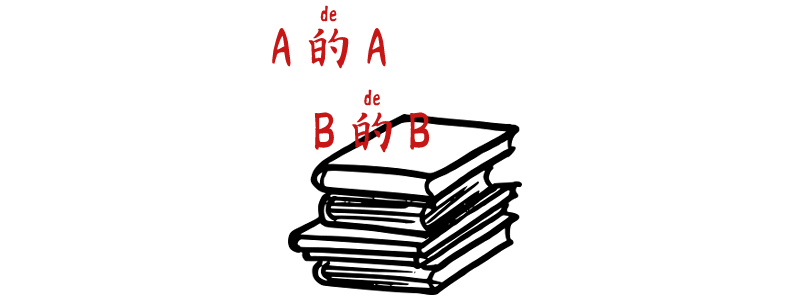Grammar Point:
The colloquial pattern is used to describe a situation where each person or thing has its own characteristic, role, or condition. It emphasizes the individuality or diversity within a group, often giving a sense of balance, division, or order.
Structure
A 的 de A,B 的 de B
A refers to one group or condition, while B refers to another, and depending on the context, it can involve nouns, verbs or adjectives. This pattern highlights how different people or groups are doing different things, each fulfilling their own role.
家裡老的老,小的小家里老的老,小的小
At home, the elderly do their thing, and the young ones do theirs.
學生們在教室裡,讀的讀,寫的寫学生们在教室里,读的读,写的写
In the classroom, some students are reading, and others are writing.
衣服大的大,小的小,沒一件合身衣服大的大,小的小,没一件合身
The clothes are either big or small, none of them fit.
菜市場的菜貴的貴,便宜的便宜,貴的不一定好,便宜的也不一定不好菜市场的菜贵的贵,便宜的便宜,贵的不一定好,便宜的也不一定不好
In the market, some vegetables are expensive, some are cheap; but expensive ones aren’t always better, and cheap ones aren’t always worse.
路上車多,人更多,騎車的騎車,走路的走路路上车多,人更多,骑车的骑车,走路的走路
The streets are crowded with cars and even more people — some are biking, and some are walking.
城市裡的房子新的新,舊的舊,但不管怎樣都很貴城市里的房子新的新,旧的旧,但不管怎样都很贵
In the city, some houses are new, some are old, but no matter what, they’re all expensive.
公司裡忙的忙,聊天的聊天公司里忙的忙,聊天的聊天
In the company, some are busy working, and others are chatting.
Differences
A 的 de A,B 的 de B
- More colloquial and rhythmic. Emphasis is on clear division or categorization.
- Often used in spoken Chinese or descriptive writing to give a vivid or poetic effect.
- Often used for observable characteristics (size, roles, actions).
有的 yǒude …有的 yǒude…
- More neutral and explicit. Describes specific examples within a group.
- Common in both spoken and written Chinese, including formal contexts.
- Often used for factual observations rather than poetic descriptions.
Situation A: If someone asks you, “Are all the furniture in your home new?
A:家裡的傢具,有的是新的,有的是舊的家里的家具,有的是新的,有的是旧的 ✅
The furniture at home, some is new, and some is old.
(This is a clear and direct response to the question. It explicitly states that some furniture is new, and some is old, making it suitable for answering factual or specific questions.)
A:家裡的傢具新的新,舊的舊家里的家具新的新,旧的旧 ❌
The furniture at home, some is new, and some is old.
(This is less explicit and more descriptive or rhetorical. It feels like you’re making an observation or description, rather than directly answering the question.)
Situation B: If you rent a house, walk in, take a look at the furniture, and say, “This place needs a bit of tidying up since…
家裡的傢具,有的是新的,有的是舊的家里的家具,有的是新的,有的是旧的 ❌
The furniture at home, some is new, and some is old.
(This works better when you want to make a detailed description or explicitly highlight specific items. It implies: “Let me break this down for you — here’s what’s new and what’s old.”)
家裡的傢具新的新,舊的舊家里的家具新的新,旧的旧 ✅
The furniture at home, some is new, and some is old.
(This works better when you’re making a quick judgment about the general state of the furniture as a whole. It implies: “The furniture is in a mix of conditions, and I can tell this right away.”)


